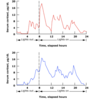Endocrine 101 Flashcards
6 hypothalamic functions
- satiety/thirst
- weight3. sleep
- temperature control
- circadian rhythm
- glycemia
outline a schematic represetnation of the interactions between higher centers, the hypothalamus, the pituitary grand and the peripheral endocrine glands.
the hypothalamus releases THYROID RELEASING HORMONE (TRH) to stimulate the pituitary, which can release TROPHIC HORMONE (TSH) which acts on the target gland (ex/ thyroid).
the Thyroid is activated and can produce hormones (ex/ thyroxine), which can be involved in a feedback loop to stop hypothalamic and pituitary hormone release.

what hormones does the posterior pituirary release
2 hormones: ADH, oxytocin
what hormones do the anterior pituitary release
- growth hormoen
- lutenising hormone LH
- follicle stimulating hormons FSH
- thyroid stimulating hormons TSh
- ACTH: adrenocorticotrophic hormone
- prolactin
pituitatry gland top 5 functions
- reproductive control
- growth
- metabolism/hemodynamic effects
- lactation/labor
- sodium concentration control
name the posterior and anterior pituitary hormones

growth hormone function
growth hormone is released from the anterior pitiuitary, and acts on multiple organs and muscles to promote their growth.

how is the anterior pituitary gland stimulated to secrete growth hormone? what hypothalamic hormone inhibits the GH release? what liver chemical inhibits GH release
the APG releases Gh in response to GROWTH HORMONE RELEASING HORMONE secreted by the hypothalamus. if SOMATOSTATIN is released by the hypothalamus, GH release by the APG is inhibited.
when GH acts on the liver, IGF-1 is secreted and negatively feedsback to the pituitary and hypothalamic system.

how does LH and FSH affect male endocrinology. Outline how it’s released
hypothalamus releases gonadotropin releasing hormone, which acts on the pituitary. the pituitary releases LH, which acts on Leydig cells to produce testosterone. the pituitary releases FSH, which acts on sertoli cells, which produces Inhibin and acts as a negative feedback regulator.

LH and FSH release in males:
hypothalamus releases __ __ hormone, which acts on the pituitary. the pituitary releases __, which acts on ___ cells to produce __. the pituitary releases FSH, which acts on __ cells, which produces __ and acts as a negative feedback regulator.
hypothalamus releases gonadotropin releasing hormone, which acts on the pituitary. the pituitary releases LH, which acts on Leydig cells to produce testosterone. the pituitary releases FSH, which acts on sertoli cells, which produces Inhibin and acts as a negative feedback regulator.
outline how LH and FSH acts in female endocrinology
hypothalamus releases GnRH, which stimulates the pituitary gland which releases LH. LH acts on the ovary, which produces progesterone and estradiole. FSH causes Inhibin release, which acts as a negative feedback reguarot

Function of TSH release. Outline mechanism of release
acts to help sodium concentration control.
hypothalamus releases thyroid releasing hormone (TRH). TRH acts on the ANTERIOR pituitary gland, which releases TSH (thyroid stimulating hormone). TSH acs on the thyroid gland, which releases T4 and T3. T4 and T3 act on the liver and also act as negaitve regulators in the hypothalamus

TSH mechanism;
hypothalamus releases thyroid ____mone (TRH). TRH acts on the __ pituitary gland, which releases __ (thyroid stimulating hormone). TSH acs on the __ gland, which releases __ and __. __ and __ act on the _ and also act as negaitve regulators in the __
hypothalamus releases releasing hormone (TRH). TRH acts on the ANTERIOR pituitary gland, which releases TSH (thyroid stimulating hormone). TSH acs on the thyroid gland, which releases T4 and T3. T4 and T3 act on the liver and also act as negaitve regulators in the hypothalamus
outline the hypothalamic pituitary adrenal axis
hypothalamus releases CRH, CRH stimulates the anterior pituitary, which releases ACTH. ACTH acts on the adrenal glands to produce cortisol.

Cortisol is a ___ regulator of ADH and CRH
negative regulator of ADH and CRH









